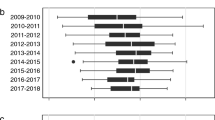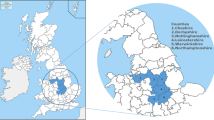Abstract
Human and livestock diseases can be difficult to control where infection persists in wildlife populations. For three decades, European badgers (Meles meles) have been culled by the British government in a series of attempts to limit the spread of Mycobacterium bovis, the causative agent of bovine tuberculosis (TB), to cattle1. Despite these efforts, the incidence of TB in cattle has risen consistently, re-emerging as a primary concern for Britain's cattle industry. Recently, badger culling has attracted controversy because experimental studies have reached contrasting conclusions (albeit using different protocols), with culled areas showing either markedly reduced2,3 or increased4,5 incidence of TB in cattle. This has confused attempts to develop a science-based management policy. Here we use data from a large-scale, randomized field experiment to help resolve these apparent differences. We show that, as carried out in this experiment, culling reduces cattle TB incidence in the areas that are culled, but increases incidence in adjoining areas. These findings are biologically consistent with previous studies2,3,4,5 but will present challenges for policy development.
This is a preview of subscription content, access via your institution
Access options
Subscribe to this journal
Receive 51 print issues and online access
$199.00 per year
only $3.90 per issue
Buy this article
- Purchase on Springer Link
- Instant access to full article PDF
Prices may be subject to local taxes which are calculated during checkout


Similar content being viewed by others
References
Krebs, J. R. et al. Bovine Tuberculosis in Cattle and Badgers Report PB3423 (HMSO, London, 1997)
Griffin, J. M. et al. The impact of badger removal on the control of tuberculosis in cattle herds in Ireland. Prev. Vet. Med. 67, 237–266 (2005)
Eves, J. A. Impact of badger removal on bovine tuberculosis in east County Offaly. Ir. Vet. J. 52, 199–203 (1999)
Donnelly, C. A. et al. Impact of localized badger culling on tuberculosis incidence in British cattle. Nature 426, 834–837 (2003)
Le Fevre, A. M. et al. The Impact of Localised Reactive Badger Culling Versus No Culling on TB Incidence in British Cattle: a Randomised Trial. http://www.defra.gov.uk/animalh/tb/isg/pdf/lefevre1005.pdf (2005).
Woodroffe, R. et al. Spatial association of Mycobacterium bovis infection in cattle and badgers. J. Appl. Ecol. 42, 852–862 (2005)
Dunnet, G. M., Jones, D. M. & McInerney, J. P. Badgers and Bovine Tuberculosis: Review of Policy (HMSO, London, 1986)
Zuckerman, S. Badgers, Cattle and Tuberculosis (HMSO, London, 1980)
Godfray, H. C. J. et al. Independent Scientific Review of the Randomised Badger Culling Trial and Associated Epidemiological Research http://www.defra.gov.uk/science/documents/publications/2004/GodfreyReport_BovineTBEpidemiology.pdf (HMSO, London, 2004)
Bourne, J. et al. An Epidemiological Investigation into Bovine Tuberculosis—Towards a Science-Based Control Strategy. Fourth Report of the Independent Scientific Group on Cattle TB http://www.defra.gov.uk/animalh/tb/isg/4th-isgreport.pdf (Department for Environment, Food & Rural Affairs, London, 2005)
Clifton-Hadley, R. S., Wilesmith, J. W., Richards, M. S., Upton, P. & Johnston, S. The occurrence of Mycobacterium bovis infection in and around an area subject to extensive badger (Meles meles) control. Epidemiol. Infect. 114, 179–193 (1995)
Roper, T. J. & Lüps, P. Disruption of territorial behaviour in badgers Meles meles. Z. Saugetierkd. 58, 252–255 (1993)
Cheeseman, C. L., Mallinson, P. J., Ryan, J. & Wilesmith, J. W. in The Badger (ed. Hayden, T. J.) 78–93 (Royal Irish Academy, Dublin, 1993)
O'Corry-Crowe, G., Hammond, R., Eves, J. & Hayden, T. J. The effect of reduction in badger density on the spatial organisation and activity of badgers Meles meles L. in relation to farms in central Ireland. Biol. Env. Proc. R. Ir. Acad. 96B, 147–158 (1996)
Tuyttens, F. A. M. et al. Spatial perturbation caused by a badger (Meles meles) culling operation: implications for the function of territoriality and the control of bovine tuberculosis (Mycobacterium bovis). J. Anim. Ecol. 69, 815–828 (2000)
Woolhouse, M. E. J. Dangers of moving cows. Nature 435, 431–432 (2005)
Bourne, J. et al. Towards a Sustainable Policy to Control TB in Cattle—A Scientific Initiative. First Report of the Independent Scientific Group on Cattle TB (Ministry of Agriculture, Fisheries & Food, London, 1998)
White, P. C. L. & Whiting, S. J. Public attitudes towards badger culling to control bovine tuberculosis in cattle. Vet. Rec. 147, 179–184 (2000)
Woodroffe, R. et al. Effects of culling on badger (Meles meles) spatial organization: implications for the control of bovine tuberculosis. J. Appl. Ecol. doi:10.1111/j.1365-2664.2005.01144.x (in the press)
Woodroffe, R., Frost, S. D. W. & Clifton-Hadley, R. S. Attempts to control tuberculosis in cattle by culling infected badgers: constraints imposed by live test sensitivity. J. Appl. Ecol. 36, 494–501 (1999)
Cresswell Associates. TB in Cattle: Report of the Independent Audit of Surveying and Badger Social Group Territory Delineation Procedures Used in The Randomised Badger Culling Trial and MAFF's Response. http://www.defra.gov.uk/animalh/tb/publications/pdf/cresswell.pdf (2001).
Woodroffe, R. et al. Welfare of badgers (Meles meles) subjected to culling: development and evaluation of a closed season. Anim. Welf. 14, 19–25 (2005)
Woodroffe, R. et al. Welfare of badgers (Meles meles) subjected to culling: patterns of trap-related injury. Anim. Welf. 14, 11–17 (2005)
Kirkwood, J. K. Humaneness of MAFF's Badger Despatch Procedures. http://www.defra.gov.uk/animalh/tb/publications/auditor/report.htm (2000).
Le Fevre, A. M. et al. Changes in Badger Setts Over the First Three Years of the Randomised Badger Culling Trial. http://www.svepm.org.uk/posters/2003/LeFevre.pdf (2003).
Acknowledgements
This study was funded and implemented by the Department of Environment, Food and Rural Affairs (Defra). We gratefully acknowledge the contribution made by the staff of Defra and its associated agencies. We also wish to thank the many farmers and land occupiers in the trial areas who allowed the experimental treatments to operate on their land. Finally, we thank D. Mollison for comments. Author Contributions F.J.B., C.A.D., D.R.C., G.G., J.P.M., W.I.M. and R.W. constitute the Independent Scientific Group on Cattle TB, which designed and oversees the RBCT. Data analyses were designed and performed by C.A.D., D.R.C., G.W., P.G., H.J., W.T.J and A.M.L.F. The manuscript was drafted by R.W. and C.A.D. with input from all co-authors.
Author information
Authors and Affiliations
Corresponding author
Ethics declarations
Competing interests
Reprints and permissions information is available at npg.nature.com/reprintsandpermissions. The authors declare no competing financial interests.
Supplementary information
Supplementary Notes
This file contains the details of the design of the trial, how analyses were performed, results from extra analyses that were undertaken to support the findings reported in the main text and details of other studies which looked at the effects of badger culling. (DOC 1349 kb)
Supplementary Data
This file contains all raw data that was used to produce the main results. (XLS 101 kb)
Rights and permissions
About this article
Cite this article
Donnelly, C., Woodroffe, R., Cox, D. et al. Positive and negative effects of widespread badger culling on tuberculosis in cattle. Nature 439, 843–846 (2006). https://doi.org/10.1038/nature04454
Received:
Accepted:
Published:
Issue Date:
DOI: https://doi.org/10.1038/nature04454
This article is cited by
-
Difference in differences analysis evaluates the effects of the badger control policy on bovine tuberculosis in England
Scientific Reports (2024)
-
Impact of test, vaccinate and remove protocol on home ranges and nightly movements of badgers in a medium density population
Scientific Reports (2023)
-
Effect of legal regulation of supplemental feeding on space use of red deer in an area with chronic wasting disease
European Journal of Wildlife Research (2023)
-
Dead-reckoning elucidates fine-scale habitat use by European badgers Meles meles
Animal Biotelemetry (2022)
-
Genetic variability and population size covary positively across nine badgers (Meles meles) populations in France
Mammal Research (2022)
Comments
By submitting a comment you agree to abide by our Terms and Community Guidelines. If you find something abusive or that does not comply with our terms or guidelines please flag it as inappropriate.



